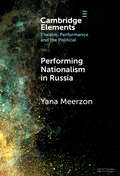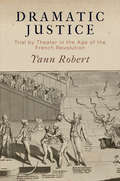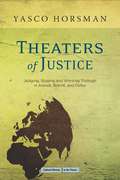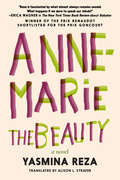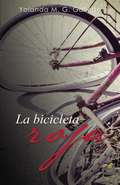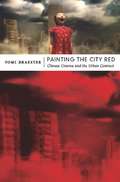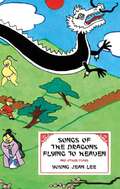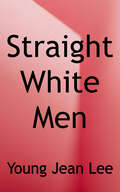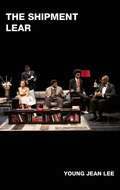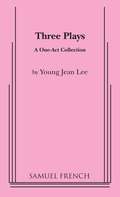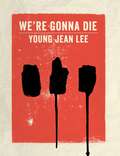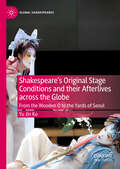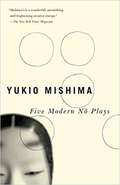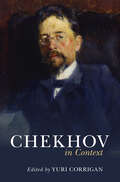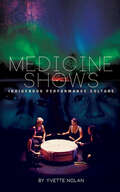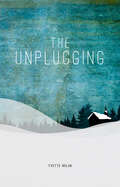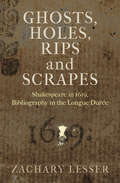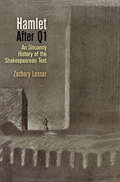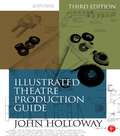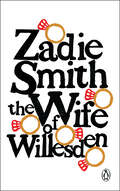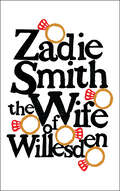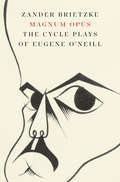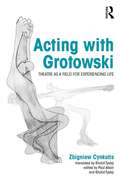- Table View
- List View
Performing Nationalism in Russia (Elements in Theatre, Performance and the Political)
by Yana MeerzonFollowing Homi Bhabha's prompt on reading nationalism as a set of discursive and performative practices, this Element focuses on the cultural geography of today's Russia and examines a range of performative strategies used by the Russian state to uphold its nationalist project. Simultaneously, it maps artistic strategies of resistance to the ideology of nationalism as employed by both state-funded and independent theatre companies, via new dramaturgies, performance practices and strategies of storytelling.
Dramatic Justice: Trial by Theater in the Age of the French Revolution
by Yann RobertFor most of the seventeenth and eighteenth centuries, classical dogma and royal censorship worked together to prevent French plays from commenting on, or even worse, reenacting current political and judicial affairs. Criminal trials, meanwhile, were designed to be as untheatrical as possible, excluding from the courtroom live debates, trained orators, and spectators. According to Yann Robert, circumstances changed between 1750 and 1800 as parallel evolutions in theater and justice brought them closer together, causing lasting transformations in both.Robert contends that the gradual merging of theatrical and legal modes in eighteenth-century France has been largely overlooked because it challenges two widely accepted narratives: first, that French theater drifted toward entertainment and illusionism during this period and, second, that the French justice system abandoned any performative foundation it previously had in favor of a textual one. In Dramatic Justice, he demonstrates that the inverse of each was true. Robert traces the rise of a "judicial theater" in which plays denounced criminals by name, even forcing them, in some cases, to perform their transgressions anew before a jeering public. Likewise, he shows how legal reformers intentionally modeled trial proceedings on dramatic representations and went so far as to recommend that judges mimic the sentimental judgment of spectators and that lawyers seek private lessons from actors. This conflation of theatrical and legal performances provoked debates and anxieties in the eighteenth century that, according to Robert, continue to resonate with present concerns over lawsuit culture and judicial entertainment.Dramatic Justice offers an alternate history of French theater and judicial practice, one that advances new explanations for several pivotal moments in the French Revolution, including the trial of Louis XVI and the Terror, by showing the extent to which they were shaped by the period's conflicted relationship to theatrical justice.
Theaters of Justice: Judging, Staging, and Working Through in Arendt, Brecht, and Delbo
by Yasco HorsmanWhat role do legal trials have in collective processes of coming to terms with a history of mass violence? How does the theatrical structure of a criminal trial facilitate and limit national processes of healing and learning from the past? This study begins with the widely publicized, historic trials of three Nazi war criminals, Eichmann, Barbie, and Priebke, whose explicit goal was not only to punish, but also to establish an officially sanctioned version of the past. The Truth and Reconciliation commissions in South America and South Africa added a therapeutic goal, acting on the belief that a trial can help bring about a moment of closure. Horsman challenges this belief by reading works that reflect on the relations among pedagogy, therapy, and legal trials. Philosopher Hannah Arendt, poet Charlotte Delbo, and dramaturg Bertolt Brecht all produced responses to historic trials that reopened the cases those trials sought to close, bringing to center stage aspects that had escaped the confines of their legal frameworks.
Anne-Marie the Beauty
by Yasmina RezaAnother thought-provoking master class in how we perform life by the award-winning novelist and playwright Yasmina Reza."I was bored with my husband," says Anne-Marie, the irrepressible voice of Anne-Marie la Beauté, "but you know, boredom is part of love." Mostly she is speaking here of her more famous friend and colleague, the French actress Giselle Fayolle, in whose shadow she has spent her career. "My life was a near miss," she adds, before explaining that she enunciated well because "I loved to say the words." A very short novel with the power and resonance of a much longer one, Anne-Marie la Beauté is a profound and moving act of remembrance, a clear-eyed assessment of the hard-edged nature of fame, a meditation on aging--and a wonderfully observant and comic exploration of human foibles. In short, another thought-provoking master class in how we perform life by the peerless Yasmina Reza.
La bicicleta roja
by Yolanda María González GallegoLas personas en las que confiamos son siempre las que guardan los secretos más atroces. Meli lleva a tres de sus amigos a conocer el almacén que, una vez derribado y reconstruido, albergará el restaurante de su novio. <P><P> Sin embargo, lo que se presentaba como una tarde tranquila y relajada se convierte en un auténtico infierno cuando alguien encierra al grupo dentro del almacén. Por si fuera poco, el derribo del local tendrá lugar a la mañana siguiente. <P>El pánico ante esta situación extrema hará que los amigos acaben por desvelar secretos que habían mantenido ocultos durante mucho tiempo. Accésit en el I Certamen Textos Teatrales "Escena Canaria"
Painting the City Red: Chinese Cinema and the Urban Contract
by Yomi BraesterPainting the City Red illuminates the dynamic relationship between the visual media, particularly film and theater, and the planning and development of cities in China and Taiwan, from the emergence of the People's Republic in 1949 to the staging of the Beijing Olympics in 2008. Yomi Braester argues that the transformation of Chinese cities in recent decades is a result not only of China's abandonment of Maoist economic planning in favor of capitalist globalization but also of a shift in visual practices. Rather than simply reflect urban culture, movies and stage dramas have facilitated the development of new perceptions of space and time, representing the future city variously as an ideal socialist city, a metropolis integrated into the global economy, and a site for preserving cultural heritage. Drawing on extensive archival research, interviews with leading filmmakers and urban planners, and close readings of scripts and images, Braester describes how films and stage plays have promoted and opposed official urban plans and policies as they have addressed issues such as demolition-and-relocation plans, the preservation of vernacular architecture, and the global real estate market. He shows how the cinematic rewriting of historical narratives has accompanied the spatial reorganization of specific urban sites, including Nanjing Road in Shanghai; veterans' villages in Taipei; and Tiananmen Square, centuries-old courtyards, and postmodern architectural landmarks in Beijing. In Painting the City Red, Braester reveals the role that film and theater have played in mediating state power, cultural norms, and the struggle for civil society in Chinese cities.
Songs of the Dragons Flying to Heaven and Other Plays
by Young Jean Lee"Bold, unguarded work . . . that resists pat definition. [Young Jean] Lee has penned profane lampoons of motivational bromides (Pullman, WA) and the Romantic poets (The Appeal). Now she piles her deconstructive scorn upon ethnic stereotypes in Songs of the Dragons Flying to Heaven, a sweet-and-sour parade of Asian minstrelsy."--Time Out New York"A perverse, provocative, and very funny festival of racism . . . Songs offers not only chauvinistic monologues and ass-slapping Korean dances, but also a rigorous exploration of art-making and its associated terrors."--The Village Voice"Have you ever noticed how most Asian Americans are slightly brain-damaged from having grown up with Asian parents?" begins the Korean American protagonist of Songs of the Dragons Flying to Heaven, the singular work of Young Jean Lee, whose plays are like nothing you have ever seen or read. This is the first collection by the downtown writer-director, whose explorations of stereotypes of race, gender, and religion are unflinching--and seat-squirming funny. Also includes Groundwork of the Metaphysic of Morals; The Appeal; Pullman, WA; Church; and Yaggoo.Young Jean Lee was born in Korea and moved to the United States at age two. She grew up in Pullman, Washington, and attended college at the University of California, Berkeley, where she also studied Shakespeare in the English PhD program before moving to New York. She is the founder of the Young Jean Lee's Theater Company, where she directs her own work, and has toured internationally in Vienna, Hanover, Berlin, Switzerland, Brussels, Norway, France, and Rotterdam; and across the United States in Portland, Seattle, Pittsburgh, and Minneapolis. She is the recipient of a 2007 Emerging Playwright OBIE Award.
Straight White Men: Untitled Feminist Show
by Young Jean LeeTwo plays by the award-winning dramatist, the first Asian-American female playwright to be produced on Broadway. <p><p>In Straight White Men, it's Christmas Eve, and Ed has gathered his three adult sons to celebrate with matching pajamas, trash-talking, and Chinese takeout. But when a question they can't answer interrupts their holiday cheer, they are forced to confront their own identities. <p><p>In Untitled Feminist Show, six charismatic stars of the downtown theatre, dance, cabaret, and burlesque worlds come together to invite the audience on an exhilaratingly irreverent, nearly-wordless celebration of a fluid and limitless sense of identity.
The Shipment and Lear
by Young Jean Lee"A subversive, seriously funny new theater piece by the adventurous playwright Young Jean Lee. . . . Ms. Lee does not shy away from prodding the audience's racial sensitivities--or insensitivities--in a style that is sometimes sly and subtle, sometimes as blunt as a poke in the eye."--Charles Isherwood, The New York Times"Lee is a facetious provocateur; she does whatever she can to get under our skins--with laughs and with raw, brutal talk . . . [and with] so ingenious a twist, such a radical bit of theatrical smoke and mirrors, that we are forced to confront our own preconceived notions of race."--Hilton Als, The New YorkerWith The Shipment, her latest work taking on identity politics, Young Jean Lee "confirms herself as one of the best experimental playwrights in America" (Time Out New York). The Korean American theater artist has taken on cultural images of black America, in a play that begins with sketches of African American clichés--an angry, foul-mouthed comedian; an aspiring young rapper who ends up in prison--and ends with a seemingly naturalistic parlor comedy, which slyly reveals the larger game Lee is playing, leaving us to consider the many ways that we see the world through a racial lens.Young Jean Lee is a playwright, director, and artistic director of her own OBIE Award-winning theater company, which as been producing her plays since 2003. Her other works include Songs of Dragons Flying to Heaven, Church, The Appeal, and Pullman, WA, and they have been produced across the country and internationally.
Three Plays
by Young Jean LeeYoung Jean Lee, OBIE award-winning playwright and director who has been called "the most adventurous downtown playwright of her generation" by The New York Times and "one of the best experimental playwrights in America" byTime Out New York, presents her early work in this collection of three one-acts. Included in this collection are: The Appeal, Groundwork of the Metaphysic of Morals, Pullman, WA
We're Gonna Die
by Young Jean Lee"Sly, weird, and thoroughly winning . . . Bracing, funny, and, yes, consoling."--The New York Times"Young Jean Lee will give you whiplash. Her ability to stake out aesthetic territory and then abruptly abandon it makes her unpredictable; her tendency to excel at each new genre makes her terrifying. In the enormously touching cabaret-style We're Gonna Die, Lee jettisons everything that has armored this au courant young playwright against the world. . . . Lee purchases our hearts with her bravery's own coin."--Time Out New YorkInspired by her personal experiences with despair and loneliness, the Obie Award-winning playwright-provocateur and her band Future Wife create a life-affirming show that anyone can perform, about the one thing everyone has in common: we're all gonna die. Each book includes a CD of all six songs and eight monologues performed by David Byrne, Laurie Anderson, Adam Horowitz, and others.Young Jean Lee has been hailed as "one of the best experimental playwrights in America" by Time Out New York. She has written and directed nine shows in New York with Young Jean Lee's Theater Company and toured her work to over twenty cities around the world. Her other plays include The Shipment, Lear, and Songs of the Dragons Flying to Heaven. Awards include two Obies, the Festival Prize of the Zuercher Theater Spektakel, a Prize in Literature from the American Academy of Arts and Letters, a Guggenheim Fellowship, and a Doris Duke Artist Award.
Shakespeare's Original Stage Conditions and their Afterlives across the Globe: From the Wooden O to the Yards of Seoul (Global Shakespeares)
by Yu Jin KoThis book brings together two separate fields by combining a study of Shakespeare's original stage conditions with an exploration of his plays in performance across the globe. The book contributes new insights into how early-modern stage conditions shaped the writing, production, and reception of Shakespeare's plays, but takes the further step of examining how original stage conditions re-emerge, not only in Globe replicas like the London Globe, but in unexpected and sometimes unconscious reconfigurations in adaptations and productions from around the world: film versions of Othello from Mexico to India that take dancing cues and anxieties about dance from the play and centralize dance; Korean adaptations for the madang (or yard) that reimagine Shakespeare's theatrical spaces and their relationships to audiences; Noh re-imaginings on film and onstage that foreground the theatrical; a teen film remake of Othello that raises questions about how blackness is figured today and on Shakespeare's stage, among others. By studying original stage conditions and their global afterlives, the book illuminates how global productions negotiate historical and cultural differences and thereby, paradoxically, engage with the cultural specificities of the present.
Five Modern No Plays (Vintage International)
by Yukio MishimaJapanese No drama is one of the great art forms that has fascinated people throughout the world. The late Yukio Mishima, one of Japan's outstanding post-war writers, infused new life into the form by using it for plays that preserve the style and inner spirit of No and are at the same time so modern, so direct, and intelligible that they could, as he suggested, be played on a bench in Central Park. Here are five of his No plays, stunning in their contemporary nature and relevance—and finally made available again for readers to enjoy.
Chekhov in Context (Literature in Context)
by Yuri CorriganPremier playwright of modern theater and trailblazer of the short story, Anton Chekhov was also a practising doctor, journalist, writer of comic sketches, philanthropist and activist. This volume provides an accessible guide to Chekhov's multifarious interests and influences, with over 30 succinct chapters covering his rich intellectual milieu and his tumultuous socio-political environment, as well as the legacy of his work in over two centuries of interdisciplinary cultures and media around the world. With a Preface by Cornel West, a chronology and Further Reading list, this collection is the essential guide to Chekhov's writing and the manifold worlds he inhabited.
Annie Mae's Movement
by Yvette NolanAnnie Mae’s Movement explores what it must have been like to be Anna Mae Pictou Aquash, a woman in a man’s movement, a Canadian in America, an Aboriginal in a white-dominant culture at a time when it felt like we could really change the world. Dying under mysterious circumstances, it is still unclear what really happened to Anna Mae back in the late 70s. Instead of recounting cold facts, this play looks for the truth in examining the life and death of this remarkable Aboriginal woman; that we cannot know the consequences of our actions; that we live on in the work that we do and the people we affect long after we have passed from this world.
Medicine Shows: Indigenous Performance Culture
by Yvette NolanContemporary Indigenous theatre in Canada is only thirty-three years old, if one begins counting from the premiere of Maria Campbell’s Jessica in Saskatoon and the establishment of Native Earth Performing Arts in Toronto. Since those contemporaneous events in 1982, the Canadian community of Indigenous theatre artists has grown and inspired one another.Medicine Shows: Indigenous Performance Culture traces the work of a host of these artists over the past three decades, illuminating the connections, the artistic genealogy, and the development of a contemporary Indigenous theatre practice. Neither a history nor a chronicle,Medicine Shows examines how theatre has been used to make medicine, reconnecting individuals and communities, giving voice to the silenced and disappeared, staging ceremony, and honouring the ancestors.
The Unplugging
by Yvette NolanForced to rely upon traditional wisdom for their survival, Elena and Bern retreat from the remains of civilization to a freezing, desolate landscape where they attempt to continue their lives after the end of the world. When a charismatic stranger from the village arrives seeking their aid, the women must decide whether they will use their knowledge of the past to give the society that rejected them the chance at a future.
Ghosts, Holes, Rips and Scrapes: Shakespeare in 1619, Bibliography in the Longue Duree
by Zachary LesserFour years before the publication of the First Folio, a group of London printers and booksellers attempted to produce a "collected works" of William Shakespeare, not in an imposingly large format but as a series of more humble quarto pamphlets. For mysterious reasons, perhaps involving Shakespeare's playing company, the King's Men, the project ran into trouble. In an attempt to salvage it, information on the title pages of some of the playbooks was falsified, making them resemble leftover copies of earlier editions. The deception worked for nearly three hundred years, until it was unmasked by scholars in the early twentieth century. The discovery of these "Pavier Quartos," as they became known, was a landmark success for the New Bibliography and played an important role in establishing the validity and authority of that method of analysis. While more recent scholars have reassessed the traditional narrative that the New Bibliographers wrote, no one has gone back to look at the primary evidence: the quartos themselves.In Ghosts, Holes, Rips and Scrapes Zachary Lesser undertakes a completely fresh study of these playbooks. Through an intensive bibliographical analysis of over three hundred surviving quartos, Lesser reveals evidence that has gone entirely unseen before: "ghosts" (faint, oily impressions produced when one book is bound next to another); "holes" (the tiny remains of the first simple stitching that held pamphlets together); and "rips and scrapes" (post-production alterations of title pages). This new evidence—much of it visible only with the aid of enhanced photographic methods—suggests that the "Pavier Quartos" are far more mysterious, with far more consequential ramifications for book history and Shakespeare scholarship than we have thought.
Hamlet After Q1: An Uncanny History of the Shakespearean Text
by Zachary LesserIn 1823, Sir Henry Bunbury discovered a badly bound volume of twelve Shakespeare plays in a closet of his manor house. Nearly all of the plays were first editions, but one stood out as extraordinary: a previously unknown text of Hamlet that predated all other versions. Suddenly, the world had to grapple with a radically new--or rather, old--Hamlet in which the characters, plot, and poetry of Shakespeare's most famous play were profoundly and strangely transformed. Q1, as the text is known, has been declared a rough draft, a shorthand piracy, a memorial reconstruction, and a pre-Shakespearean "ur-Hamlet," among other things. Flickering between two historical moments--its publication in Shakespeare's early seventeenth century and its rediscovery in Bunbury's early nineteenth--Q1 is both the first and last Hamlet. Because this text became widely known only after the familiar version of the play had reached the highest pinnacle of English literature, its reception has entirely depended on this uncanny temporal oscillation; so too has its ongoing influence on twentieth- and twenty-first-century ideas of the play. Zachary Lesser examines how the improbable discovery of Q1 has forced readers to reconsider accepted truths about Shakespeare as an author and about the nature of Shakespeare's texts. In telling the story of this mysterious text and tracing the debates in newspapers, London theaters, and scholarly journals that followed its discovery, Lesser offers brilliant new insights on what we think we mean by Hamlet.
Aristophanes and the Poetics of Competition
by Zachary P. BilesAthenian comic drama was written for performance at festivals honouring the god Dionysos. Through dramatic action and open discourse, poets sought to engage their rivals and impress the audience, all in an effort to obtain victory in the competitions. This book uses that competitive performance context as an interpretive framework within which to understand the thematic interests shaping the plots and poetic quality of Aristophanes' plays in particular, and of Old Comedy in general. Studying five individual plays from the Aristophanic corpus as well as fragments of other comic poets, it reveals the competitive poetics distinctive to each. It also traces thematic connections with other poetic traditions, especially epic, lyric, and tragedy, and thereby seeks to place competitive poetics within broader trends in Greek literature.
Illustrated Theatre Production Guide
by Zachary StriblingIllustrated Theatre Production Guide delivers a step-by-step approach to the most prevalent and established theatreproduction practices, focusing on essential issues related to the construction of wooden, fabric, plastic, and metal scenery used on the stage. A must-have resource for both the community theatre worker who must be a jack of all trades and the student who needs to learn the fundamentals on his or her own, it covers the necessities in great detail, without bogging you down. Offering techniques and best-practice methods from an experienced industry expert, it will allow you to create a foundation on which to build a successful and resourceful career behind the scenes in theatre production. This third edition has been completely restructured to more effectively lead you through the basics of stagecraft. Through detailed lessons and hundreds of drawings, author John Holloway offers you solutions to the problems that you’ll face every day in a production, from rigging to knot tying. New to this edition are guides to jobs in theatre, construction documentation, and video projection methods, with expanded information on Thrust Theatres, lighting, audio and video practices.
The Wife of Willesden
by Zadie SmithZadie Smith's first time writing for the stage, a riotous twenty-first century translation of Geoffrey Chaucer's classic The Wife of Bath&“Married five times. Mother. Lover. Aunt. Friend. She plays many roles round here. And never Scared to tell the whole of her truth, whether Or not anyone wants to hear it. Wife Of Willesden: pissed enough to tell her life Story to whoever has ears and eyes . . .&” In her stage-writing debut, celebrated novelist and essayist Zadie Smith brings to life a comedic and cutting twenty-first century translation of Geoffrey Chaucer&’s classic The Wife of Bath. The Wife of Willesden follows Alvita, a Jamaican-born British woman in her mid-50s, as she tells her life story to a band of strangers in a small pub on the Kilburn High Road. Wearing fake gold chains, dressed in knock-off designer clothes, and speaking in a mixture of London slang and patois, Alvita recalls her five marriages in outrageous, bawdy detail, rewrites her mistakes as triumphs, and shares her beliefs on femininity, sexuality, and misogyny with anyone willing to listen. A thoughtful reimagining of an unforgettable narrative of female sexual power, written with singular verve and wit, The Wife of Willesden shows why Zadie Smith is one of the sharpest and most versatile writers working today.
The Wife of Willesden
by Zadie SmithZadie Smith's first time writing for the stage, a riotous twenty-first century translation of Geoffrey Chaucer's classic "The Wife of Bath"&“Married five times. Mother. Lover. Aunt. Friend. She plays many roles round here. And never Scared to tell the whole of her truth, whether Or not anyone wants to hear it. Wife Of Willesden: pissed enough to tell her life Story to whoever has ears and eyes...&” In her stage-writing debut, celebrated novelist and essayist Zadie Smith brings to life a comedic and cutting twenty-first century translation of Geoffrey Chaucer&’s classic The Wife of Bath. The Wife of Willesden follows Alvita, a Jamaican-born British woman in her mid-50s, as she tells her life story to a band of strangers in a small pub on the Kilburn High Road. Wearing fake gold chains, dressed in knock-off designer clothes, and speaking in a mixture of London slang and patois, Alvita recalls her five marriages in outrageous, bawdy detail, rewrites her mistakes as triumphs, and shares her beliefs on femininity, sexuality, and misogyny with anyone willing to listen. A thoughtful reimagining of an unforgettable narrative of female sexual power, written with singular verve and wit, The Wife of Willesden exemplifies why Zadie Smith is one of the sharpest and most versatile writers working today.
Magnum Opus: The Cycle Plays of Eugene O'Neill
by Zander BrietzkeAn original and provocative analysis of Eugene O'Neill's unfinished cycle play project From 1935 to 1939, Eugene O&’Neill worked on a series of plays that would trace the history of an American family through several generations. He completed just two of the proposed eleven plays—A Touch of the Poet and More Stately Mansions—which Zander Brietzke argues represent the core of the entire cycle. Combining archival research, literary analysis, and theatrical imagination, Magnum Opus invites an audience to see this unusual and exciting epic as a historical drama of our time.
Acting with Grotowski: Theatre as a Field for Experiencing Life
by Zbigniew Cynkutis‘Zbigniew Cynkutis’ writings constitute invaluable testimony of his work with Jerzy Grotowski during the ‘theatre of productions’ phase and beyond. Cynkutis’ insights elucidate aspects of the Laboratory Theatre’s praxis and provide a unique perspective on the questions most often asked about Grotowski. Authored by one of the Laboratory Theatre’s most accomplished actors, this book draws on long-term theatre research and deep knowledge of the craft of acting to offer practical advice indispensable to the professional and aspiring actor alike. The volume offers the English-speaking reader an unprecedented richness of primary source material, which sheds new light on the practical work of one of the most influential theatre directors of the 20th century. Cynkutis’ voice is sincere and direct, and will continue to inspire new generations of theatre practitioners.’ – Dominika Laster, Yale University Acting with Grotowski: Theatre as a Field for Experiencing Life explores the actor-director dynamic through the experience of Zbigniew Cynkutis, one of Polish director Jerzy Grotowski’s foremost collaborators. Cynkutis’s work as an actor, combined with his later work as a director and theatre manager, gave him a visionary overview based on precise embodied understanding. Cynkutis’s writings yield numerous insights into the commitment needed to make innovative, challenging theatre. A central component of Acting with Grotowski is his distinctive approach to training: ‘Conversations with the Body’ includes a range of techniques and approaches to warming up, rehearsing and creating work from a physical starting point, beautifully illustrated by Bill Ireland. The book comprises reflections and practical suggestions on a range of subjects – theatre and culture, improvisation, ethics, group dynamics, and Cynkutis’s vision for the Wrocław Second Studio. It contains visual and textual materials from Cynkutis’s own private archive, such as diary entries and letters. Acting with Grotowski demonstrates the thin line that separates life and art when an artist works with extreme commitment in testing political and social conditions.
